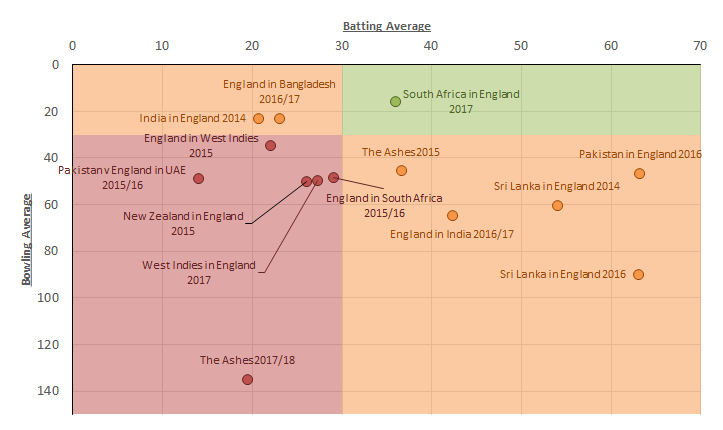
A gradual but inevitable descent into cricket-based loathing and bile.
I Ride And I Ride, I Ride Through The City’s Backside
Coming up with new ideas for articles isn’t the easiest thing in the world – there are only so many times that you can use the old ‘blank article’ joke (and it’s already been pencilled in for a 2017/18 Ashes Review article) or just abuse the shit out of Danny Morrison before people start to get tired and drift away. And that’s just the writers. But, in the absence of any new ideas, trawling through the back catalogue to find something that can be updated isn’t the worst idea in the world.
And thus, we found this an old article from a mere five and half years ago: Passengers and the Ramprakash Factor. After just a brief flick through the general gist of it (it seems to mostly be about how Ravi Bopara wasn’t very good), it was clear that it was crying out for a bit of a rejig and an update, using the ideas we introduced in our Botham’s Eleven and Botham’s Twelve articles. We’re pretty sure this would be called a ‘mashup’ in the young person’s vernacular.
Something that we’ve touched on several times before is looking at the magic numbers for a Test allrounder: a batting average above 30 and a bowling average below 30. However, this has generally been in the context of an entire career. Here we’ll look at it on an individual series basis, and classify each series based on the results:
- A batting average of 30 or more and a bowling average below 30 is an ‘all-round‘ series.
- A batting average of 30 or more and a bowling average of 30 or more is a ‘batting only’ series.
- Similarly, a batting average of less than 30 and a bowling average below 30 is ‘bowling only’.
- A batting average below 30 and bowling average above 30 gets the dreaded ‘passenger’ label.
- Any series where a player doesn’t have a batting average or bowling average is a ‘no result’.
Having classified each series, we can then judge a player on the proportion of series that fall into each category. In particular, we can look at how often they are passengers, But before we get into that, this wouldn’t be a 51allout Scorer’s Notes piece without at least one unnecessarily over-complicated graph. So here’s Moeen Ali’s series by series breakdown. Each series is represented by a scatter point, with the x-axis value being the batting average and the y-axis bowling average (with the numbers in reverse, so that the top right corner is the best and the bottom left the worst). This shows us a few important things, the first of them being that Moeen’s Ashes series to date has been absolutely horrifically awful. It’s hard to understate how much this has impacted England’s plans – not having a spinner able to keep any sort of control (let alone take wickets) has forced the quicks to bowl more overs than would be ideal (i.e. more than zero in the case of Jake Ball), resulting in a race towards zero on the speed gun. The sheer fact that Joe Root seems to prefer bowling Dawid Malan says more than real evidence ever could. Had we not forgotten about him being in the squad, Mason Crane would surely have merited a Propaganda Machine piece at the start of the tour, explaining how he’s the new Shane Warne.
This shows us a few important things, the first of them being that Moeen’s Ashes series to date has been absolutely horrifically awful. It’s hard to understate how much this has impacted England’s plans – not having a spinner able to keep any sort of control (let alone take wickets) has forced the quicks to bowl more overs than would be ideal (i.e. more than zero in the case of Jake Ball), resulting in a race towards zero on the speed gun. The sheer fact that Joe Root seems to prefer bowling Dawid Malan says more than real evidence ever could. Had we not forgotten about him being in the squad, Mason Crane would surely have merited a Propaganda Machine piece at the start of the tour, explaining how he’s the new Shane Warne.
Beyond that fact, it’s noticeable that from Moeen’s 14 series, there’s only a single result in the top right quadrant: the England vs. South Africa series from earlier this year (where Moeen was named man of the series). That’s a series success rate of around 7%. Some other things that we can think of that are only successful around 7% of the time are David Moyes, FIFA games on Nintendo consoles and 51allout’s jokes.
So, having laid the boot into Moeen and included the requisite picture of an attractive young lady, we can now turn our attention to the other great allrounders of our time and make the same comparison in tabular form. Basically, how many of the series that they played would be in each quadrant, and who would be the passengerest of said players?
| Player | All-round | Bowling only | Batting only | Passenger | No result | Passenger Percentage |
|---|---|---|---|---|---|---|
| Pollock | 16 | 14 | 4 | 1 | 5 | 2.5% |
| Miller | 6 | 5 | 1 | 1 | 0 | 7.7% |
| Kallis | 16 | 4 | 31 | 5 | 5 | 8.2% |
| Sobers | 8 | 1 | 10 | 2 | 1 | 9.1% |
| Imran Khan | 10 | 7 | 5 | 3 | 3 | 10.7% |
| Noble | 2 | 5 | 1 | 1 | 0 | 11.1% |
| Hadlee | 8 | 16 | 3 | 4 | 2 | 12.1% |
| Watson | 2 | 6 | 8 | 3 | 4 | 13.0% |
| Greig | 6 | 1 | 6 | 2 | 0 | 13.3% |
| Jayasuria | 8 | 6 | 7 | 8 | 24 | 15.1% |
| Cairns | 8 | 5 | 7 | 5 | 3 | 17.9% |
| Botham | 8 | 8 | 7 | 7 | 2 | 21.9% |
| Stokes | 4 | 1 | 5 | 3 | 0 | 23.1% |
| Wasim | 4 | 22 | 4 | 10 | 3 | 23.3% |
| Rhodes | 4 | 4 | 2 | 4 | 2 | 25.0% |
| Kapil Dev | 9 | 7 | 11 | 10 | 1 | 26.3% |
| Shastri | 3 | 4 | 8 | 8 | 1 | 33.3% |
| Mankad | 3 | 2 | 2 | 4 | 0 | 36.4% |
| Benaud | 2 | 5 | 3 | 6 | 0 | 37.5% |
| Vettori | 7 | 11 | 13 | 20 | 1 | 38.5% |
| Flintoff | 4 | 5 | 4 | 10 | 2 | 40.0% |
| Moeen | 1 | 2 | 5 | 6 | 0 | 42.9% |
Shaun Pollock’s position at the top of the table is genuinely remarkable – he was a passenger in just one of his 40 series (at home to Australia in 2005/6 when he averaged 14.25 with the bat and 66.25 with the ball across two Tests). After him comes Keith Miller, Jacques Kallis and Garry Sobers who were all, apparently, also quite decent back in the day. But the real interest is at the bottom of the table, where one Andrew Flintoff edges out Moeen for the relative comfort of 21st place. So there we are – Moeen is officially not as good as the greatest allrounders to ever play Test cricket: conclusive proof, if ever it was needed.
Although based on this metric, Shane Watson seems to be the eight greatest allrounder in the history of Test cricket, so it’s possible that we’ve messed up the numbers somewhere. And there’s almost certainly any number of genuinely decent allrounders that we’ve forgotten altogether – if you think of one, let us know in the comments section and we’ll add them in (before deleting your comment, to make it look like we definitely didn’t balls things up first time round).


1 Comment
Post a Comment
1
Stuart
03 Jan 2018 14:01
If you look at percentage of series that are classed as just All-Round, Shane Watson drops to second bottom. That’s better!